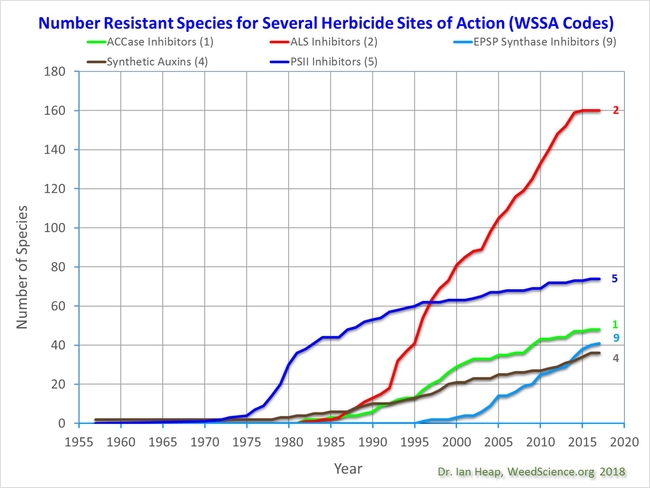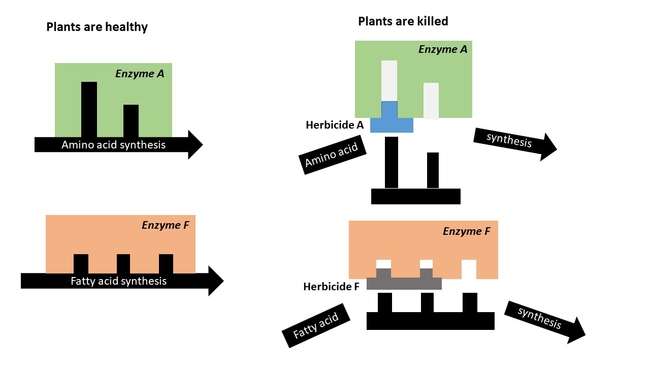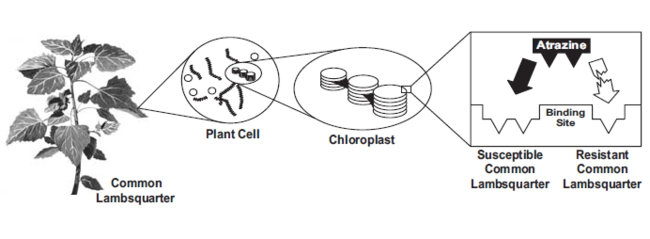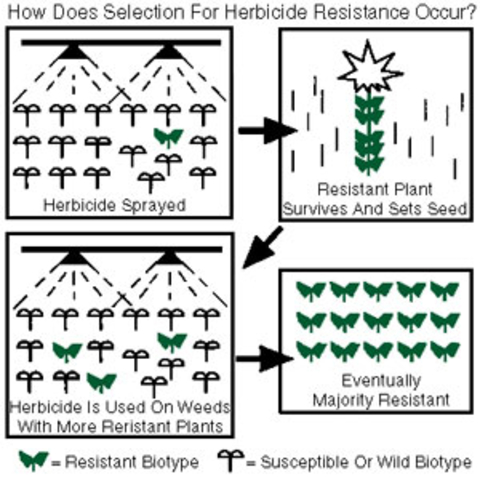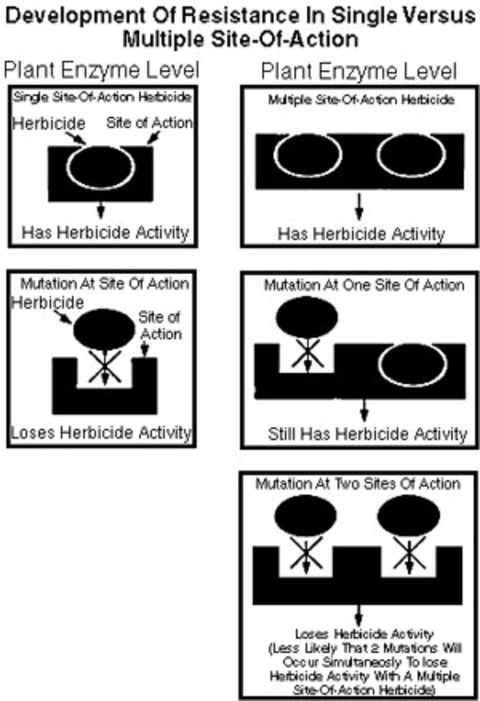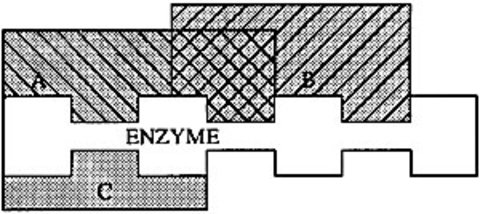When herbicide options become limited, there are significant economic and environmental consequences. Fortunately, there are things you can do to prevent and manage herbicide-resistant weeds.
Understanding herbicide resistance
Weeds’ resistance to herbicides isn’t a unique phenomenon. In fact, pesticide resistance is a worldwide problem that’s not confined to any single pest category.
-
1908: First report of insects resistant to insecticides.
-
1940: First report of plant pathogens resistant to fungicides.
-
1968: First report of weeds resistant to herbicides (triazines).
By 1991,120 weed biotypes were resistant to triazine herbicides and 15 other herbicide families were documented throughout the world. Since then, nearly 500 unique cases of herbicide resistance have been reported. Figure 1 reflects this worldwide trend of increasing herbicide resistance.
The International Survey of Herbicide Resistant Weeds notes 21 unique cases of herbicide resistance in Minnesota, including four cases where biotypes are resistant to two sites of action:
- Biotypes of three weed species resistant to photosystem II inhibitors (PSII) (Group 5). Species include common lambsquarters, velvetleaf and redroot pigweed.
- Biotypes of three weed species resistant to ACCase inhibitors (Group 1). Species include wild oat and two cases of giant green foxtail.
- Biotypes of seven weed species resistant to ALS inhibitors (Group 2). Species include kochia, common cocklebur, tall waterhemp, giant foxtail, giant green foxtail, yellow foxtail, and common ragweed.
- Biotypes of three weed species resistant to glyphosate (Group 9). Species include giant ragweed, tall waterhemp, and common ragweed.
- A tall waterhemp biotype is resistant to PPO inhibitors (Group 14).
- Biotypes of three species are resistant to two sites of action: ALS inhibitors (2) and glyphosate (9). Species include tall waterhemp, giant ragweed, and common ragweed.
- A tall waterhemp biotype is resistant to two sites of action: PPO inhibitors (14) and glyphosate (9).
Indeed, pests have proven to be ecologically and biochemically adaptable to agrichemicals.
Even though there are many herbicide options for corn, soybean and small grains, crop producers should be concerned about whether a weed biotype is resistant to a particular herbicide.
Many herbicide options could quickly be lost for several crops if a weed biotype is resistant to more than one herbicide (i.e., cross-resistance). Obviously, losing herbicide options could have important economic and environmental consequences for agriculture.
Also, in an era of high re-registration costs for older herbicides and high development costs for new herbicides, the possibility of replacing the lost herbicides due to resistance diminishes.
Finally, in most cases, it won’t be easy or inexpensive to assess resistant weed biotypes. Due to cross-resistance, many resistance problems may have to be solved by trial and error, which could be quite expensive for crop producers.
Fortunately, there are solutions to the herbicide resistance issue. Perhaps the best place to start is to consider herbicides as a resource that needs to be preserved. Strategies for resistance prevention follow from there.
Site of action
Site of action refers to the biochemical site within the plant that the herbicide directly interacts with. Some herbicide site of action interactions are well understood, while others are unknown.
Many of the well-known sites of action are enzymes or proteins essential to plant growth and development (Figures 2 and 3). Also, some herbicides are believed to act at multiple sites.
Enzymes
Enzymes function as steps in biological processes. They’re are also extremely specialized in their function. As a result, many different enzymes are involved with the many different biological processes that occur within a plant.
Some herbicides can stop specific enzymes from functioning. This disrupts specific plant processes and often leads to a plant’s death. This herbicide-enzyme relationship is very specific, and any chemical modification of the herbicide or enzyme can eliminate herbicidal activity.
Photosynthetic inhibitors
The photosynthetic process occurs within a plant cell’s chloroplasts. Certain herbicides can inhibit photosynthesis by binding to specific sites within the chloroplast.
An herbicide’s relationship to the chloroplast binding site is very specific. Any modification of the herbicide or binding site can eliminate herbicidal activity.
Metabolism
Metabolism refers to the biochemical processes within the plant that generally modify herbicides to less toxic compounds. Differential rates of metabolism between crops and weeds is a primary method of crop selectivity to herbicides. One metabolic process may affect several different herbicide families.
Herbicide families
Herbicide families are a convenient way of organizing herbicides that share a common chemical structure and have similar herbicidal activity. Two or more herbicide families may affect the same site of action and express similar herbicidal activity and injury symptoms.
Biotype
A biotype is a group of plants within a species that has biological traits that aren’t common to the population as a whole. For example, the Pursuit-resistant corn hybrid Pioneer 3377 IR is a biotype of Pioneer 3377 and atrazine-resistant common lambsquarters is a biotype of common lambsquarters. In most instances, specific biotypes aren’t easily recognizable by casual observation.
Selection intensity
In herbicide resistance, selection intensity is the degree to which weed control measures (e.g., herbicides) in a cropping system give a competitive advantage to a weed or crop biotype resistant to a particular herbicide.
Herbicide susceptibility
Herbicide susceptibility means a particular weed or crop biotype is killed by the recommended use rate of the herbicide.
Herbicide resistance
Herbicide resistance refers to the inherited ability of a weed or crop biotype to survive an herbicide application that the original population was susceptible to. Currently, the three known resistance mechanisms plants employ are:
-
An alteration of the herbicide site of action.
-
Metabolism of the herbicide.
-
Removal of the herbicide from the target site (sequestration).
Herbicide cross-resistance
Herbicide cross-resistance refers to a weed or crop biotype that has evolved a mechanism or mechanisms of resistance to one herbicide that also allows it to be resistant to other herbicides.
Herbicide cross-resistance can occur within the same or in different herbicide families and sites of action. For example, after extensively using herbicide A in a field, selection of a weed biotype resistant to herbicide A is found to also be resistant to herbicide B, although herbicide B was never used in that field.
Herbicide multiple resistance
Herbicide multiple resistance refers to a weed or crop biotype that has evolved mechanisms of resistance to more than one herbicide, with separate selection processes bringing about the resistance.
For example, after a weed or crop biotype developed resistance to herbicide A, then herbicide B was used and resistance evolved to herbicide B. The plant is now resistant to herbicides A and B through two separate selection processes.
Selection for change in weed populations begins when a small number of plants (a biotype) within a weed species has a genetic makeup that enables them to survive a particular herbicide application.
The origin of this difference in genetic makeup isn’t clear. However, herbicides aren’t known to directly cause the genetic change (i.e., mutation) that allows resistance.
This means the resistant biotype is present in low numbers in natural populations. When an herbicide is applied, most of the susceptible weeds die, but the few resistant weeds survive, mature and produce seed. If the same herbicide continues to be applied and the resistant weeds reproduce, eventually the majority of the weeds will be resistant to the herbicide (Figure 4).
Preventing herbicide-resistant weeds
It’s difficult to predict exactly which weed species will have biotypes resistant to a given herbicide. However, we’ve learned from previous pesticide resistance problems that the occurrence of herbicide-resistant weeds is directly linked to:
- The herbicide program used.
- The weed species present.
- The crop management practices employed.
In a sense, selection intensity acts like a filter that can screen out susceptible weed biotypes while leaving resistant biotypes.
By definition, herbicides are effective weed killers and have the potential to exert heavy selection intensity on weeds. The more susceptible a weed species is to a given herbicide (i.e., the greater the weed control), the greater the selection intensity.
As a result, the selection rate for resistance can be quite rapid if the same herbicide or herbicides with the same site of action are repeatedly used in a particular field.
Detecting herbicide resistance
With such highly effective herbicides, you’d think the increase in the number of herbicide-resistant biotypes would be readily observable. This isn’t the case. Resistant biotypes generally are only detectable when they make up about 30 percent of the population.
During the first several years of a weed control program that relies on only one herbicide, the proportion of resistant biotypes is very low (less than 1 percent of the population). As long as the application of this herbicide continues and the resistant biotypes reproduce, the proportion of the population that’s resistant will increase.
When resistance starts
It’s very common to go from excellent control of a particular weed species to very poor control within a growing season. A gradual performance decline is rarely seen.
Figure 5 illustrates the predicted rapid increase in the proportion of a kochia population that’s resistant following repeated annual applications of the sulfonylurea herbicide Glean.
In field situations, resistance to sulfonylurea herbicides has been reported after three to five years of repeated use. With triazine herbicides, resistance has generally appeared after seven or more years of repeated use.
Therefore, an herbicide-resistance problem could develop after repeatedly using a product for more than two years, depending on the proportion of the population initially resistant to an herbicide.
The herbicide characteristics that affect herbicide resistance are:
Herbicides that act on a single site of action.
Herbicides applied multiple times during the growing season.
Herbicides used for several consecutive growing seasons or repeated application of herbicides with the same site of action, regardless of whether the crop changed.
Herbicides used without other weed control options (e.g., cultivation) that are considered stand-alone weed control programs.
Single site of action herbicides
Several herbicide families only interfere with a single site of action. They include the following:
ALS inhibitors (Group 2)
ESPS synthase inhibitors (glyphosate) (Group 9)
AACase inhibitors (Group 1)
Seedling root inhibitors (Group 3)
Photosynthesis inhibitors (Groups 5-7)
Cell membrane disrupters (Groups 14 and 22)
Pigment inhibitors (Groups 12, 13 and 27)
Herbicides associated with specific sites of action.
Herbicides that interfere with single sites of action are generally more likely to select for resistant weeds because a change in only one gene may be enough to affect an herbicide's binding potential to the site of action. Therefore, it’s more probable that a resistant weed population will develop if a difference of only one gene is required (Figure 6).
Multiple site of action herbicides
Weeds are less likely to evolve resistance to herbicides with multiple action sites.
This is based on the reasoning presented for single site of action herbicides. Essentially, if an herbicide has multiple action sites, existing biotypes are less likely to have the genetic differences at all the sites of action that will result in resistance (Figure 6).
Herbicide families with multiple action sites include the growth regulators (Groups 4 and 19) and seedling shoot growth inhibitors (Groups 8, 15 and 16).
Herbicide cross-resistance and site of action
A change in a site of action that results in resistance to a particular herbicide may or may not result in resistance to other herbicides active at the same site of action. This is because there can be many different binding sites at a particular site of action (e.g., an enzyme), and those binding sites can be very herbicide-specific.
Therefore, several different herbicides may bind to the same enzyme but at different sites on the enzyme (Figure 7). As a result, it’s not possible to predict herbicide cross-resistance. However, the greatest potential for herbicide cross-resistance exists among herbicides of the same family and having the same site of action.
To illustrate cross-resistance, both the imidazolinone (e.g., Pursuit and Scepter) and sulfonylurea (e.g., Classic) herbicide families are ALS enzyme inhibitors.
However, imidazolinone-resistant (IR) corn hybrids are resistant to imidazolinone herbicides and are cross-resistant to the sulfonylurea herbicides. Imidazolinone-tolerant (IT) corn hybrids are resistant to Pursuit and soil-applied Scepter but aren’t cross-resistant to sulfonylurea herbicides.
Herbicide resistance via altered metabolism
Regardless of whether an herbicide is active at single or multiple site(s) of action, it’s often metabolized by crops or weeds before reaching the primary site(s) of action. This means an herbicide’s metabolism rate plays a key role in determining crop injury and weed control.
The genetic regulation of a metabolic process influences the likelihood of developing herbicide resistance due to altered metabolism. For example, a change in only one gene has altered the metabolism rate of atrazine in some biotypes of atrazine-resistant velvetleaf (Abutilon theophrasti).
Most metabolic processes are thought to be controlled by multiple genes. This reduces the probability but doesn’t eliminate the possibility of herbicide-resistant weed biotypes due to enhanced metabolic capabilities or altered metabolic processes.
If it were to occur, metabolic resistance could be especially challenging. This is because a metabolic process often affects several families of herbicides that don’t share a common site of action. Regardless of the resistance mechanism, reducing the selection intensity is the key to preventing herbicide resistance.
Genetics
Weeds, by their nature, have a diverse genetic background that gives them the ability to adapt to many different environments.
For example, repeatedly mowing a lawn selects for low-growing plants that avoid or aren’t affected by repeated cutting. This is why it shouldn’t be surprising that weeds can adapt to certain herbicide programs.
Weeds with a diverse genetic background may have a resistant biotype that has a one in a million chance of occurring within a weed population. Although these odds sound remote, it can translate into a high probability of selecting for an herbicide-resistant weed biotype unless you use proper methods to reduce selection intensity.
Reproduction and seed dispersal
As an herbicide-resistant biotype becomes more predominant in the weed population, two factors increase in importance:
-
Weed reproductive capability.
-
Weed seed dispersal mechanisms.
The greater the reproductive success of the resistant biotype, the greater its potential to spread and become a dominant part of the population. Because of most weed seeds’ extended viability, once established, it’s difficult to eliminate an herbicide-resistant biotype from the population, even if you use extensive remedial weed control measures.
Weeds such as kochia can tumble for miles, spreading seed onto previously uninfested land. Diverse seed dispersal mechanisms mean farm managers must always use good herbicide-resistance management strategies to:
- Prevent resistant biotypes from developing on the land.
- Prohibit the establishment of resistant weed biotypes that spread from adjacent lands or from custom harvesting equipment and other machinery.
Before assuming that any weeds surviving an herbicide application are resistant, rule out other factors that might have affected herbicide performance:
- Misapplication.
- Unfavorable weather conditions.
- Improper herbicide application timing.
- Weed flushes after application of a non-residual herbicide.
What to watch for
If resistance appears to be a likely possibility, check for the following:
- Are other weeds listed on the product label satisfactorily controlled? Chances are only one weed species will show herbicide resistance in any given field situation. If there are several normally susceptible weed species, reconsider factors other than herbicide resistance as the cause for lack of weed control.
- Did the same herbicide or herbicide with the same site of action fail in the same area of the field the previous year?
- Do field histories indicate extensive use of the same herbicide or herbicide site of action year after year?
If one or more of these three situations apply, it’s possible the weeds are resistant to the herbicide.
If you suspect resistance
If you suspect resistance, control the weeds with a labeled herbicide having another site of action or use appropriate non-chemical weed control methods to prevent the weeds from going to seed.
Then, contact your local crop consultant or Extension educator, state weed specialist and the appropriate chemical company to develop a comprehensive weed control program to manage the problem.
Recent research efforts have aimed to breed herbicide resistance into crops. For minor-use crops, it may be more economical to breed herbicide resistance into a crop than to develop new selective herbicides for current crop varieties.
Using herbicide-resistant crops
For major-use crops such as corn, soybeans and wheat, herbicide-resistant crops may be useful where difficult-to-control weeds or environmental conditions dictate using specific herbicides that the crop is normally susceptible to.
Using herbicide-resistant crops could enhance the potential for selecting for herbicide-resistant weeds unless you carefully follow management practices.
Once again, the key is selection intensity. Misusing herbicide-resistant crops could encourage the use of a single herbicide or herbicide family over several crop rotations, enhancing the selection intensity for herbicide-resistant weeds.
Selecting herbicide-resistant crops
Carefully evaluate herbicide-resistant crop varieties or hybrids for other performance characteristics (e.g., yield). Then, compare these characteristics to all other suitable hybrids or varieties in the marketplace, whether they have herbicide resistance or not.
This ensures you’ll get the best overall agronomic value for your money. It’ll also be very important to keep accurate records of the herbicide-resistant crops’ exact planting location to avoid misapplying herbicide.
Prevention and management strategies
The North Central Weed Science Society (NCWSS) Herbicide Resistance Committee developed the following strategies for avoiding and managing problems with herbicide-resistant weed biotypes.
Keep in mind that relying on any one strategy isn’t likely to be effective. You must use the following strategies in carefully selected combinations to avoid or properly manage herbicide-resistant weed problems:
1. Only use herbicides when necessary
Where available, base herbicide applications on economic thresholds. Continued development of effective economic threshold models should be helpful.
2. Rotate herbicides (sites of action)
Don’t make more than two consecutive applications of herbicides with the same site of action to the same field unless the management system includes other effective control practices. Two consecutive applications could be single annual applications for two years, or two split applications in one year.
3. Apply herbicides that include multiple sites of action
Apply herbicides in tank-mixed, prepackaged or sequential mixtures that include multiple sites of action. For this strategy to be effective, both herbicides must have substantial activity against potentially resistant weeds.
Remember that in the past, weeds selected for herbicide resistance often weren’t the primary target species. It may be expensive to apply herbicide combinations that duplicate a wide spectrum of weed control activity. Many of the more economical herbicide combinations may not be adequate.
View the Take Action Herbicide Classification guide for a list of premixes and their corresponding sites of action.
4. Rotate crops, particularly those with different life cycles
An example is winter annuals such as winter wheat, perennials such as alfalfa and summer annuals such as corn or soybeans. Also, remember not to use herbicides with the same site of action in these different crops against the same weed, unless you also include other effective control practices in the management system.
5. Avoid more than two consecutive herbicide applications with herbicide-resistant crops
Planting new herbicide-resistant crop varieties shouldn’t result in more than two consecutive applications of herbicides with the same site of action against the same weed unless other effective control practices are also included in the management system.
6. Include mechanical weed control practices
Where feasible, combine mechanical weed control practices such as rotary hoeing and cultivation with herbicide treatments.
7. Consider primary tillage
Where soil erosion potential is minimal, consider primary tillage as a component of the weed management program.
8. Regularly scout fields to identify the weeds present
Quickly respond to changes in weed populations to restrict the spread of weeds that may have been selected for resistance.
9. Clean tillage and harvest equipment
Clean before moving from fields infested with resistant weeds to those that aren’t.
10. Encourage others to adopt prevention management strategies
Encourage railroads, public utilities, highway departments and similar organizations that use total vegetation control programs to use vegetation management systems that don’t lead to the selection of herbicide-resistant weeds.
Resistant weeds from total vegetation control areas frequently spread to cropland. Chemical companies, state and federal agencies and farm organizations can all help in this effort.
Green, M.B., LeBaron, H.M., & Moberg, W.K. (editors). (1990). Managing resistance to agrochemicals: From fundamental research to practical strategies (Symposium Series No. 421). American Chemical Society, pp 496.
Gressel, J. (1992). Addressing real weed science needs with innovations. Weed Technology, 6, 509-525.
Gunsolus, J.L. & Curran, W.S. (1992, revised). Herbicide Mode of Action and Injury Symptoms CD-ROM.
Heap, I. The International Survey of Herbicide Resistant Weeds. Online. Internet. Tuesday, May 29, 2018. Available www.weedscience.org
Maxwell, B.D., Roush, M.L., & Radesevich, S.R. (1990). Predicting the evolution and dynamics of herbicide-resistance in weed populations. Weed Technology, 4, 2-13.
Reviewed in 2021


